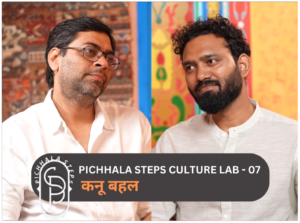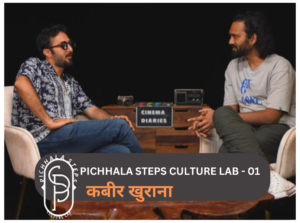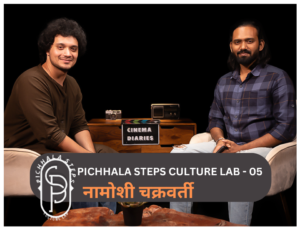Satish: Thank you very much, Milind Sir, for coming to our show.
Milind: Thank you for inviting me. Thank you so much.
Satish: If I may ask, why did you want to become a director? There are various ways to tell a story. Like, I am a writer and can tell a story as a storyteller. But you chose to be a director. Was there any particular reason behind this choice?
Milind: This is a very good question because, if you see, there’s a questionnaire in film schools, particularly abroad. I don’t know if it’s the same here, but in film studies abroad, there is a questionnaire. If you answer it, you’ll know whether you are inclined towards direction, camera, or editing. But here, we don’t have such procedures. So, you have to decide it yourself. No external agency or system will tell you. Actually, it exists. If you want to tell it to new students, you can use that method. I use that method in my workshops. Sometimes kids get confused. I say, “Go through this test.” There are 30-40 questions. If you answer them, you will know whether you are inclined towards camera, direction, sound, or editing. There was no such thing in our time. We only knew that if you wanted to make a film, you had to become a filmmaker. As far as the technical aspect of the camera, I was not interested in it. I had done a lot in engineering and was bored. I wanted to deal with humans, minds, and ideas. Before FTII, let me go back a little.
Satish: Actually, my question was, at which point did you feel that this was your calling? FTII is a major decision. Once you go to FTII, you are set on a path in this field for life. I am asking because many aspiring filmmakers, like me, are out there. Your journey might help them decide on their profession. Why and how to choose?
Milind: Basically, every artist has something to say. The one who has something to say is an artist. They choose their medium based on what they like or feel capable of doing. Those who can write poetry, write poetry. Similarly, I felt direction was my medium. But it’s very difficult unless you find a mentor who recognizes your talent and trains you. Otherwise, you find your medium naturally. If you are lucky and fortunate to meet a great mentor, it helps a lot. For example, when Picasso created modern art, everyone laughed at him. But his drawing teacher recognized his extraordinary talent and took him to Paris to learn from great artists. That’s an exceptional case. Every artist has their journey. Sometimes you get a guide, sometimes you don’t, and you become your own guide. My journey was driven by a desire to prove myself and to create something meaningful.
Satish: You passed out from FTII and assisted Sanjay Leela Bhansali. You were a part of his first and second films. Today, he is a big name. Tell us about your journey with him. What did you learn from him?
Milind: Bhansali is indeed a school in himself. When I joined him, he was making his first film with the same insecurities and uncertainties. But he was tremendously confident because he knew what he was making. He worked hard on preparation, discipline, and thinking. That was the first thing I learned—hard work, focus, and having a clear vision. He gives a lot of freedom to the technical team. For instance, he lets the cameraman take 3-4 days for lighting if needed. He believes in detailed perfectionism. From the start, he knew what he wanted and trusted his team to deliver.
Satish: In Indian cinema, we have a lot of genres like romance, drama, political thrillers, and comedies. But science fiction is an area that few filmmakers explore. Why do you think that is?
Milind: Indian cinema is very popular and commercial, often following preset norms and formulas. Science fiction requires a certain level of understanding and education, which is not widespread among our audiences. Making science fiction is expensive due to VFX and sets. For a film to be economically feasible, it needs a large audience that understands it. Our filmmakers also haven’t developed their skills in this direction. However, with the advent of OTT and increasing education levels, I believe there is now a sufficient audience for science fiction. We need to develop a school of thought for science fiction, nurture writers, and collaborate to create good scripts. We should also start making short science fiction films with the support of VFX studios to build a foundation for this genre.
Satish: As you said, the previous audience of the 80s or 90s preferred melodrama, romance, and mass entertainment. Now, you believe the Gen Z and newer generations are more inclined towards exploring science, technology, and diverse cinema. Despite this, why do big producers in India still hesitate to invest in science fiction, knowing there’s a growing interest?
Milind:It’s a combination of factors. Firstly, there’s still a perception that science fiction is risky and expensive. Big-budget films like historical epics or war dramas have a proven track record and a ready audience. Producers are naturally risk-averse and prefer to invest in genres with established returns. Secondly, our filmmakers often stick to what they know. Successful directors and producers continue making the genres they are comfortable with and that have brought them success.
But I believe the tide is changing. With OTT platforms exposing audiences to global cinema, there’s a growing appreciation for varied genres, including science fiction. The challenge now is for our industry to recognize this shift and invest in developing the skills and infrastructure needed for science fiction. We need dedicated efforts to nurture this genre, create compelling content, and trust that there is an audience ready for it.
Satish: You mentioned successful filmmakers haven’t built a “school of thought” around science fiction in India. Could you elaborate on what you mean by that and how it can be changed?
Milind: When I say “school of thought,” I mean a dedicated, systematic approach to nurturing and developing a genre. In Hollywood, filmmakers like George Lucas, Steven Spielberg, and James Cameron didn’t just make successful science fiction films—they created a legacy. They trained new filmmakers, inspired writers, and pushed technological boundaries. They made science fiction a respected and economically viable genre. In India, despite a few successful attempts, we haven’t seen a sustained effort to build on these successes.
To change this, we need to start with education and collaboration. We should have workshops and seminars focusing on science fiction writing and filmmaking. VFX studios could support new filmmakers by providing resources to create short films. We should encourage associations and collaborations among writers, directors, and producers to develop scripts and concepts. By building a community of science fiction enthusiasts and creators, we can gradually establish a robust foundation for this genre in Indian cinema.
Satish: That’s a fascinating perspective. So, where do you see the future of science fiction in Indian cinema? What steps need to be taken immediately to kickstart this movement?
Milind:The future of science fiction in Indian cinema is promising if we take deliberate steps to nurture it. We need to start by creating awareness and interest among young filmmakers and audiences. Here are a few immediate steps we can take:
- Education and Training: Introduce dedicated courses and workshops on science fiction filmmaking in film schools. Include sessions on writing, VFX, and the science behind the fiction.
- Collaboration:Form associations of writers, directors, and producers interested in science fiction. Encourage them to share ideas, scripts, and resources.
- Short Films: Encourage the creation of science fiction short films with the support of VFX studios. These can serve as proof of concept and help build a portfolio of work in the genre.
- Funding and Grants: Establish grants and funding opportunities specifically for science fiction projects. This could be through government initiatives or private sponsors who believe in the potential of the genre.
- Audience Engagement: Use social media and other platforms to engage with audiences, share science fiction concepts, and gauge interest. Screen short films and pilot projects to build a fan base.
By taking these steps, we can build a strong foundation for science fiction in Indian cinema and ensure it becomes a thriving genre in the future.
Satish: Thank you so much, Milind Sir, for sharing your insights and experiences. It’s been a pleasure talking to you and understanding your journey and vision for the future of Indian cinema.
Milind:Thank you, Satish. It was wonderful discussing these ideas with you. I hope our conversation inspires many aspiring filmmakers and helps shape the future of Indian cinema.




